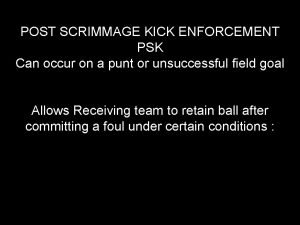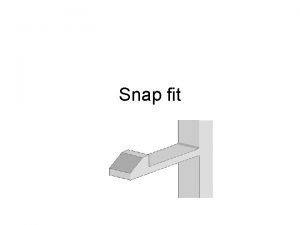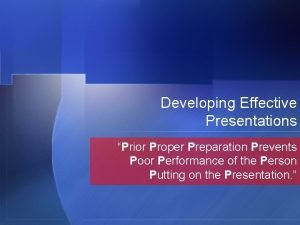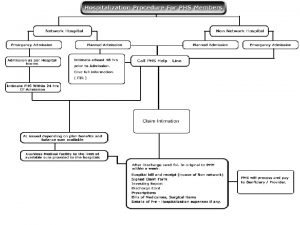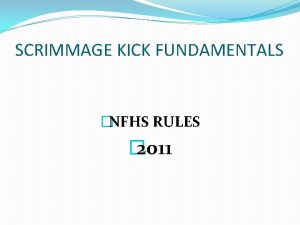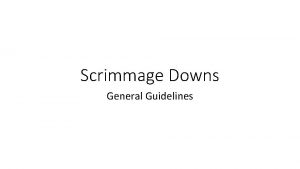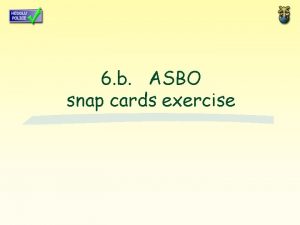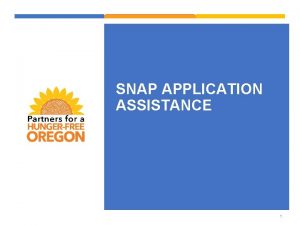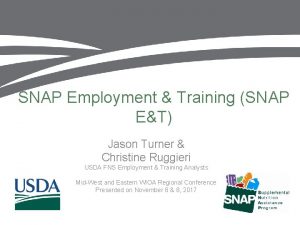SCRIMMAGE REQUIREMENTS Prior To Snap 1 COMMUNICATE COMMUNICATE






- Slides: 6

SCRIMMAGE REQUIREMENTS Prior To Snap 1. COMMUNICATE, COMMUNICATE !!!!! 2. The neutral zone is established when the referee declares the ball ready for play 3. Once the snapper touches the ball, he must keep one hand on it. If he puts both hands on the ball, he may take one hand off if he does so without simulating the beginning of play. 4. The snapper must clearly pause after touching the ball and before it is snapped.

before the snap. 2. Offense must have at least seven players on the line of scrimmage. 3. No fewer than five linemen must be numbered 50 – 79, except in a scrimmage kick formation 4. In a scrimmage kick formation on fourth down or a try, the offense is allowed to have any number of linemen whose uniform numbers are outside the 50 -79 range. 5. If a scrimmage kick formation is used on any down other than 4 th down, only the snapper may have a number outside the 50 – 79 range. 6. One man may be in motion parallel to or away from his scrimmage line. 7. A shift is the movement of one or more offensive players before the snap. After a shift, all players must stop and remain stationary for at

Snap Location 1. Before the ready-for-play signal, the offense may designate the spot from which the ball is put in play anywhere between the hashmarks: a. For a try or kickoff b. Following a safety or touchback c. After a fair catch or an awarded fair catch d. For the start of each overtime series (NOTE: This privilege remains if the down is replayed or a dead ball foul occurs. ) Live/Dead ball 1. Whenever we blow a whistle, the ball is normally already dead. The only exception is an inadvertent whistle. 2. No foul causes the ball to become dead.

THE RUNNING The Runner 1. A runner is a player who is. GAME in possession, or is simulating possession of a live ball. 2. The runner may stiff arm and use a hand on an opponent’s helmet or face mask, but he cannot grasp or pull the tacklers face mask. The runner may also lower his head when contacted to gain yardage, but he cannot use his head to butt, ram or punish an opponent. 3. If the player in possession of the ball completely loses his helmet, the ball is immediately dead. 4. A runner is out of bounds when any part of his person or the ball touches anything, or anyone who is on or outside a sideline or end line. 5. The runner cannot be assisted by a teammate who pushes, pulls or lifts him to assist his forward progress. 6. A runner may not grasp a teammate.

Handoffs 1. It is legal for any player to hand the ball backward at anytime. 2. Handing the ball forward is not allowed when either player is beyond the neutral zone or after a change of possession. 3. Handing the ball forward is allowed when both players are behind the neutral zone. 4. Illegal forward handing is only a foul if the handoff is completed. Fumbles 1. When a fumble goes out of bounds between the goal lines, the ball is dead and belongs to the fumbling team at the out of bounds spot. 2. When the offensive team fumbles in the field of play and the ball goes into the end zone and out of bounds there, the ball belongs to the team defending that goal and it is a touchback or safety depending on which team provided the force.

Forward Progress 1. A runner is down when any part of his body other than a hand or foot touches the ground or his forward momentum is stopped. Forward progress is marked at the ball’s foremost point when that occurs and is considered the dead ball spot. 1. 2. 3. 4. 5. 6. When In Doubt The runner is held so that forward progress is stopped rather than a fumble The runner has not fumbled as he contacts the ground The runners facemask is grabbed, twisted, turned or pulled The runner’s knee has not touched the ground The runner is inbounds rather than out of bounds The ball is dead in the field of play rather than out of bounds
